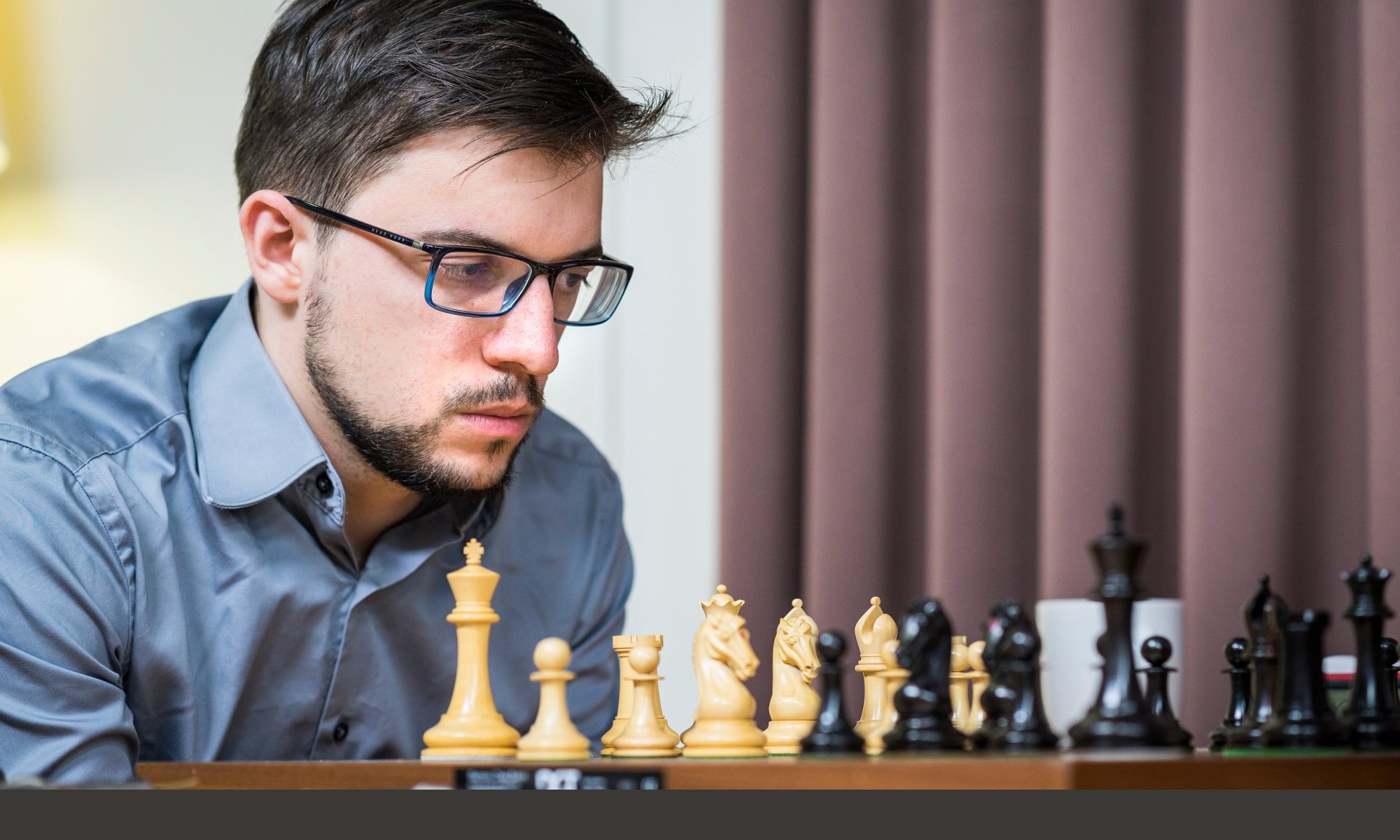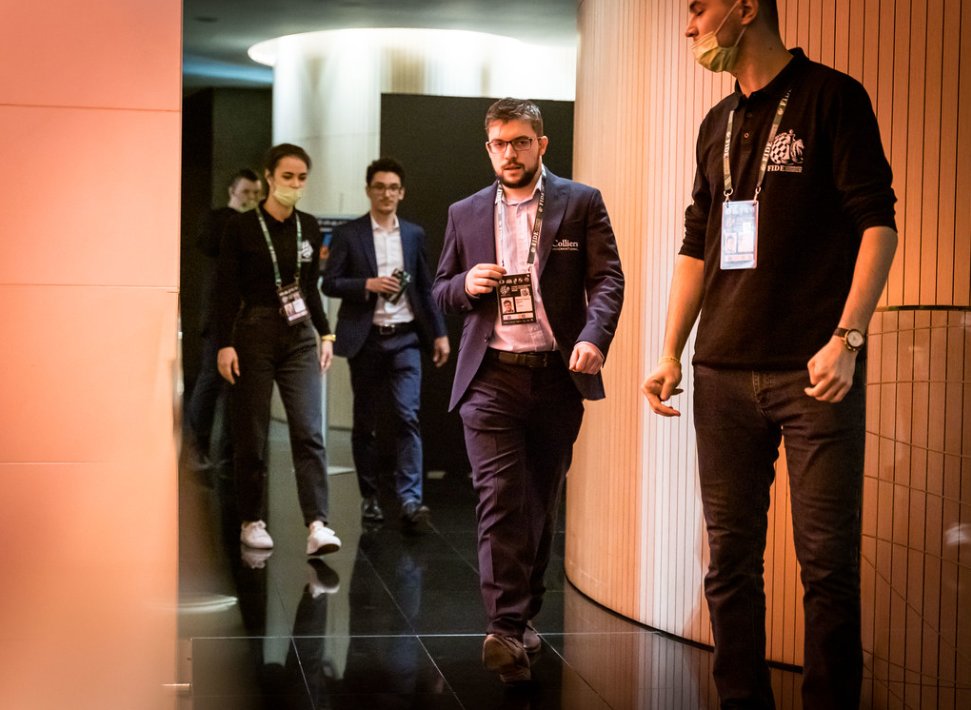When I came back from a few days vacation in the U.S. early March, the world was still going around pretty much normally. The Charles de Gaulle airport I had just left was usually crowded. Of course, we knew that there was a significant risk of the coronavirus pandemic spreading, but nothing like the magnitude of the pandemic that has taken place since then. I hadn’t yet arrived in my apartment when a private Facebook message from FIDE told me that there might be a spot available for the Candidate Tournament and if so, would I be willing to participate? I had to make up my mind very quickly, as the confirmation should come one or two days later.
Of course, I didn’t hesitate for long and said yes. Immediately, there was a whole organization to set up. I called my manager Laurent Vérat; how do you get there with the limited time? How to manage the visa to be recovered, with the restrictions that were already beginning to be put in place by Russia concerning foreign visitors? And I called my coach Etienne Bacrot, to see with him how to set up in such a short time an operational team, the computers that are needed etc… After that, it was a race against time to get ready, to pick up the visa at the Russian Consulate in Marseille, and then to arrive well in advance in Ekaterinburg, in order to anticipate the last minute problems. As a result, I passed through Istanbul to avoid Moscow, with a « short » 9-hour stopover anyway, but it went rather well! I finally arrived at 7am – local time – at Ekaterinburg airport, where I was welcomed by the organization, without being quarantined 🙂 .

Once I got into the Hyatt Regency, I hardly left it for two weeks. This is both related to the quality of the line-up, since clearly, during a chess tournament of this level, you don’t get out much, but also to avoid being stupidly contaminated. For example, I didn’t go jogging outside or anything like that. That would have been foolish, especially since there was a gym in the hotel. Among my rare outings, I went out to eat twice with Mr. Coffinier, France Consul General in Ekaterinburg. Otherwise, I alternated between the hotel restaurant and room service.
The negative aspect of this forced rush is that with so little time, I could not have anyone to accompany me there. There was no second, so I was on my own for the duration of the tournament. That said, I’m used to it and I can obviously work with my seconds from a distance.
From the chess point of view, there was obviously quite a lot of additional work to be done, but on the spot, it was the usual routine; review the opening files accurately and arrive at the game as well armed as possible. What was good for me was that the games started at 4pm. That allowed me to go to the gym often at lunchtime, and try to stay fit. And then, despite everything, I still had a few moments of relaxation, even though there was a serious lack of sport on TV 🙂 . In the end, it was mainly Netflix that was running, apart from the chess preps of course.
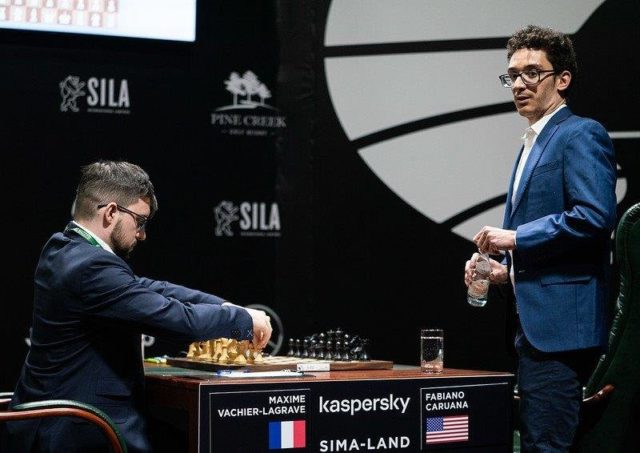
Eventually, the tournament got off to a flying start on 17 March.
Round 1: Mvl – Caruana (2842) 1/2
Even if we suspected that there would be change, we weren’t sure what to expect in terms of opening. Arkhangelsk was one of the possibilities we had considered. But Fabiano was really well prepared for that game and although white, I was the one who had a bit of a problem. I reacted pretty well afterwards and, despite a couple of inaccuracies on both sides, the draw was a logical result.
A game with quite a lot of content, quite a lot of things to calculate. A good warm-up to get into the tournament.
Round 2: Mvl – Ding Liren (2805) 1-0
The sequence of two straight white games to start the tournament was obviously critical. It will be the same when the tournament starts again, I will have two successive black games which will be crucial as well. Of course, with 2 whites, it’s clear that 1.5/2 was the score I was aiming for, as much when it is 2 blacks, it will be rather 1 out of 2 I guess 🙂 . But then, we will also see the circumstances of the tournament. We can’t predict that for the moment.
Anyway, it was clear to me that I had to put pressure on Ding. And so the opening went very, very well.
We had looked at this 12.Bd2 idea before the tournament. It leads to positions not very easy to play for Black, in particular in the line chosen with …Nd8, and this Knight which remains badly placed for a long time. So I win more or less the game in the opening, especially after 18.c4! which grabs a pawn.
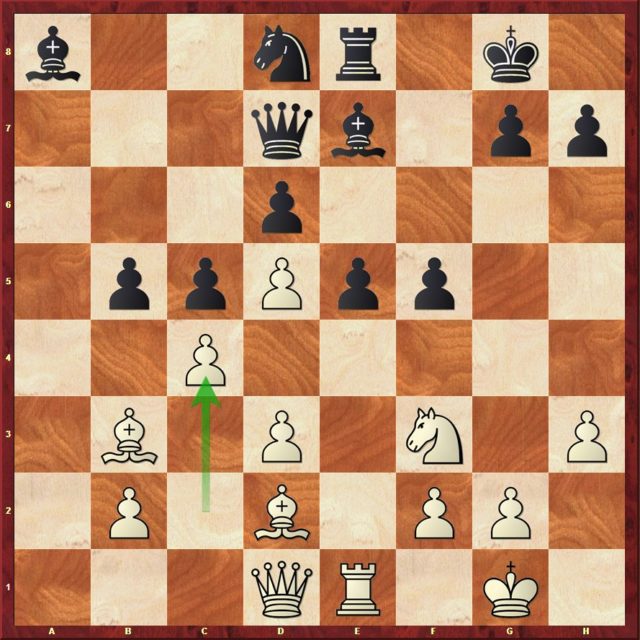
If 18…. Bf6 19.cxb5 Qf7, then 20.Bg5! is very strong. I suspect Ding missed this when he played 15…f5?. Then, the technical conversion was made easier by the fact that the Ba8 and Nd8 remained completely out of play. All that was needed were a few precise moves, notably 20.Nh2!.
It’s true that the start of the tournament was rather encouraging in terms of content, especially the fact that I was able to give Ding problems in the opening, despite my short preparation.
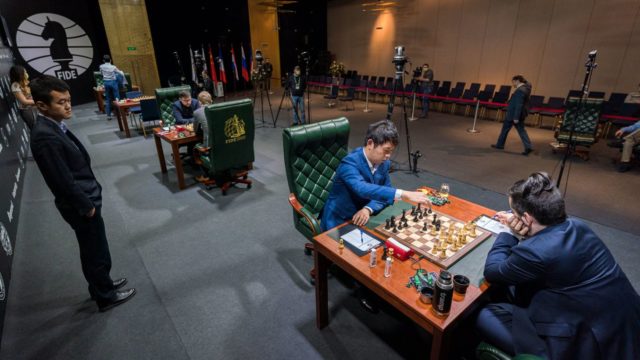
Round 3: Giri (2763) – Mvl 1/2
Giri is really sharp on his preps, and I was a little bit in trouble in the opening. He came up with a good idea and the position was slightly unpleasant for me to play. Afterwards, I think I defended well, even though he might have had more ambitious options at some point, but they weren’t necessarily easy to find. I’m thinking of 17.Bb5, to provoke …a6, which has been mentioned by commentators; that, for example, I hadn’t thought of.
As a result, I was rather happy with my transition to an endgame. I knew I was a bit worse, but with the pawn in d4 and the possibility to activate my Knight, I felt I wasn’t going to lose it. Even though Anish wasn’t necessarily very precise at the beginning of this ending.
Round 4: Mvl – Grischuk (2777) 1/2
Frankly, I didn’t understand his time management at all! Why 52 minutes out of 18…Ne7, in a position that we both knew about? On the other hand, in the complications, he reacted very well. He apprehended with class all the difficulties, and in particular found all the only moves, 21…Na4 then 22…Bd5, 24…Rg6 and 25…Bc4; a succession of really not easy decisions…
And then, when the situation became really ultra tactical after 29.a4,
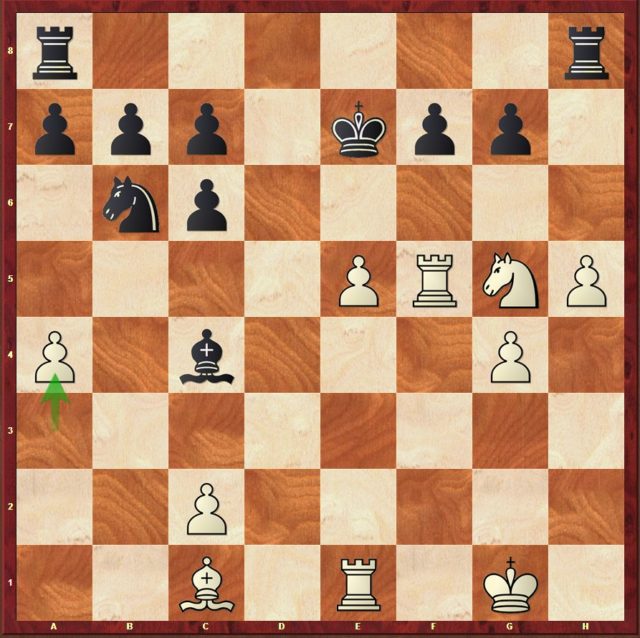
he made the mistake 29…Nxa4?. I had anticipated he would take and saw quite a few options but what happened was that I obviously looked at the skewer with 30.Re4 or 30.Rf4, but I was rather on 30.Rf4, after which there are no winning ideas like after 30.Re4! b5 31.Rxc4! followed by 32.Rxf7+.
So, when I played 29.a4, for me black’s only move was to take a4 and I had anticipated the game’s continuation with 30.Ba3+ ; I remember that I thought 2’30” to decide if I was going to play 30.Ba3+ directly, or first 30.e6. Anyway, I have a little regret that I missed 30.Re4!.
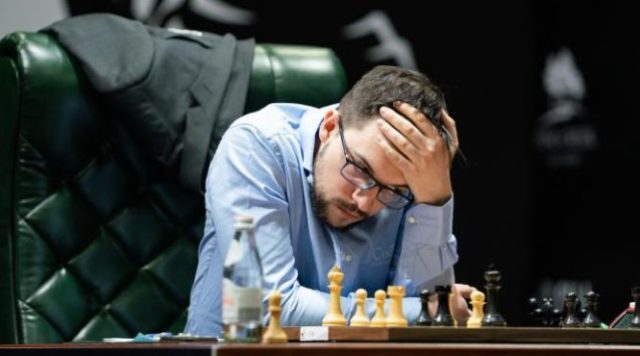
Also, I must say I underestimated his option with 35…a5! at the end of the sequence.
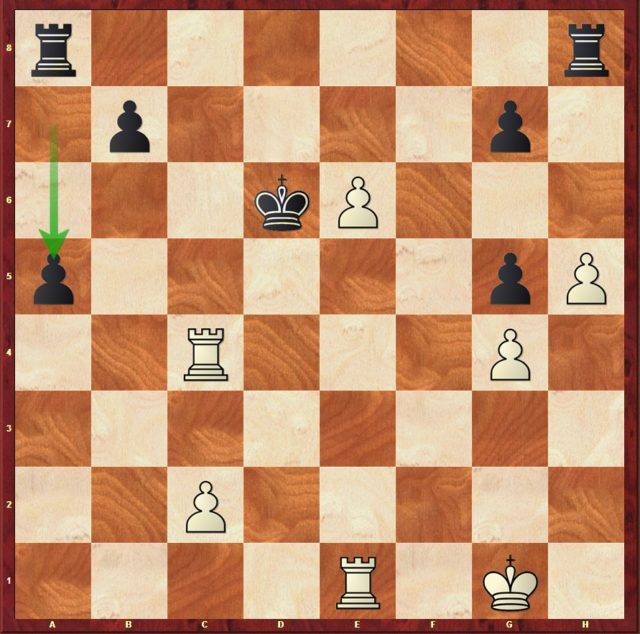
The four-Rook endgame is clearly superior if he doesn’t have 35…a5!. After that, 36.Rd4+ was the natural move. But I found it really easy to handle for Black. Whereas on 36.Rd1+ Kxe6 37.Re4+ Kf7 38.Rd7+ Kf6 39.Rd5 Kf7 40.Rf5+ Kg8 41.Re7, I thought I still had some small chances of winning; which is not the case, simply 41…Rh7! should draw.
And then, after 36…Ke7 37.Re4, as he played in the game, I thought I really had real chances. But he found all the correct follow-ups, despite his heavy time trouble. The moves are not easy, he must give pawns, he must concede squares… For example, understanding that he has to play 35…a5 is already huge. Certainly, it is natural to push the passed pawn, but on the other hand, it gives so many squares to white that one could imagine that it is necessary to put a Rook in play first. Maybe some other moves would have drawn as well, but 35…a5 is much more clinical. Anyway, Grischuk’s defence was really impressive on the whole.
It was a warning that in a tournament like the Candidates, the opportunities you have, you shouldn’t let them pass you by too often!
Round 5: Alekseenko (2698) – Mvl 1/2
After doubling white at the beginning, I now doubled black against Alekseenko and then Wang Hao. It’s true that I would have liked to win one of these two games… Alekseenko didn’t chicken out at all, and he got head into the complications of a Najdorf line that Carlsen had played against me last December. Certainly, he made an incredible mistake in his preparation since he thought 50 minutes after 16…g6 (instead of 16…Bf8? against Carlsen):
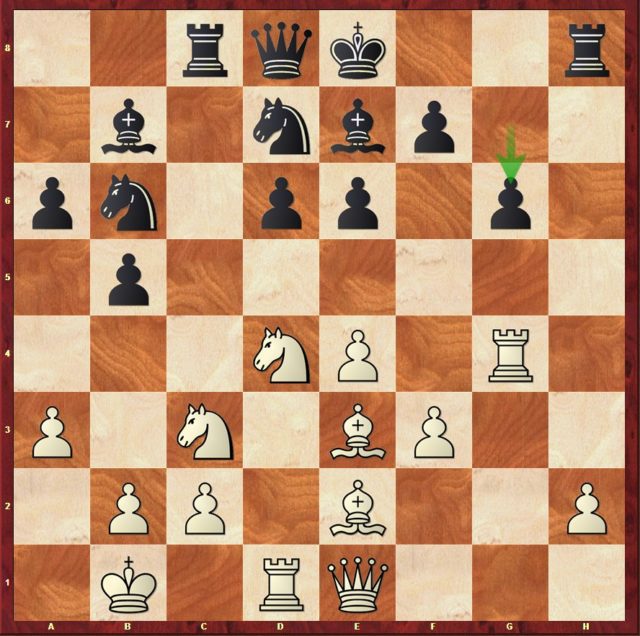
17.Rxg6 Rxc3. I didn’t understand what was going on since it was unthinkable that he didn’t look 17.Rxg6 Rxc3 at home. In fact, as he explained later, he just knew that 16…g6 was « impossible » because of 17.Rxg6!. So, in his defense, these are things that can happen. Maybe at the very beginning, the computer didn’t like 16…g6 at all, so he concentrated on 16…Rh7 or 16…Kf8.
As for me, I just had to remember about the lines, and then see on the board if an opportunity arose in case he deviated… That said, I didn’t have too much reason to be that optimistic, because there are a lot of possibilities that are a forced draw. For example 18.Qxc3 Na4 19.Qb3 fxg6 20.Nxe6 and perpetual. The line he has chosen, in fact, is the one that asks the most questions, with 18.Nxe6 Qc8 19.Ng7+ Kf8 20.Rh6. After some other correct decisions on his part, and since he had done everything well, I was obliged to sacrifice a Rook on b2 to impose a perpetual myself.
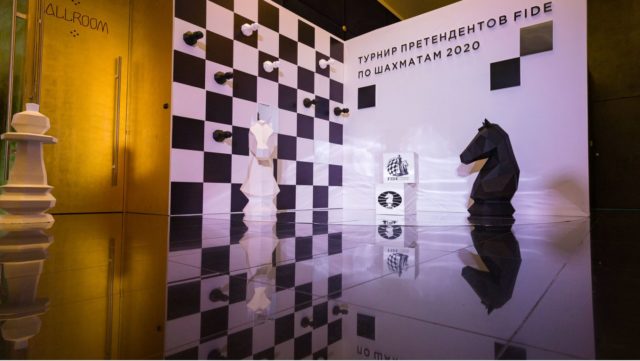
Round 6: Wang Hao (2762) – Mvl 1/2
That’s my bad game of the first half of the tournament.
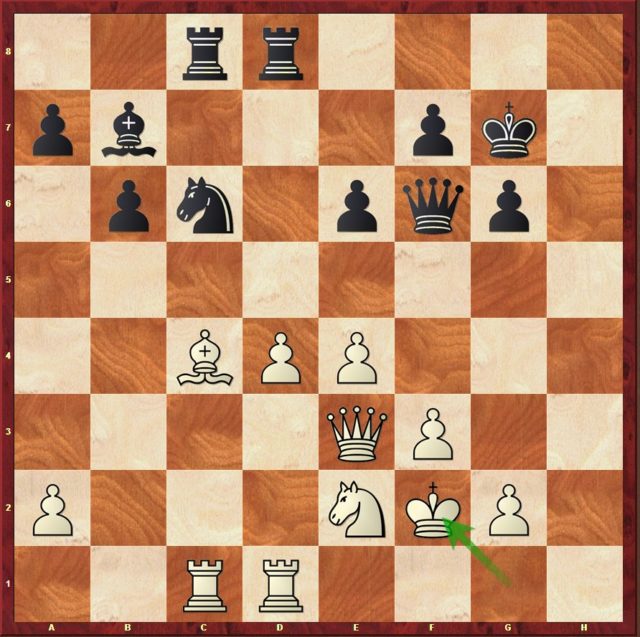
First of all, I didn’t play the obvious 22… Qh4+. I don’t know at all what I was afraid of after 23.Ng3 Qf6, but I was clearly afraid of something. Yet White has nothing better than 24.Ne2, repeating moves. So I opted for 22…Rh8 instead, and after 23.Rh1, I spent quite a lot of time calculating 23…e5 24.d5 Nd4 25.Nxd4 exd4 26.Qd3; and there I was considering 26…Rh4 and I thought it was not so bad. Black more or less threatens 27…. b5, I imagined that it would not be so trivial for White. And then, when he actually played 23.Rh1, I realized that after 26…Rh4 27.Rcd1, the d4-pawn would be lost without compensation since the White King is rather safe on f2 or e2. Certainly I can still play 27…b5, but simply 28.Bxb5 Rc3 29.Qd2! and it is over. From then on, I had to fall back on the backup variation, and exchange the four Rooks by 23…Rxh1 24.Rxh1 Rh8 25.Rxh8 Kxh8. I still thought it was OK, but I missed 26.Qc3! and it gets complicated. And after 26…Kg8 27.d5, I missed the nice pattern 27…Qh4+ 28.g3 Qh2+ 29.Ke3 exd5 30.Bxd5 because I didn’t see 30…Ba6! from afar. It was so much better than the game that I probably would have played it anyway, even though it sounds highly acrobatic.
In the game, after 26…Qxc3 27.Nxc3, the problem is that against the move I want to play, 27…Ne5, there is obviously 28.d6 which is a problem now. It may be tenable, but in fact the difference for me was that on 27…Na5 28.d6 Kf8, then I had 29…e5 which allowed me to isolate the d6-pawn. But after 27…Na5 28.Fd3! played by Wang Hao, it is objectively game over.
Then a small miracle happened.
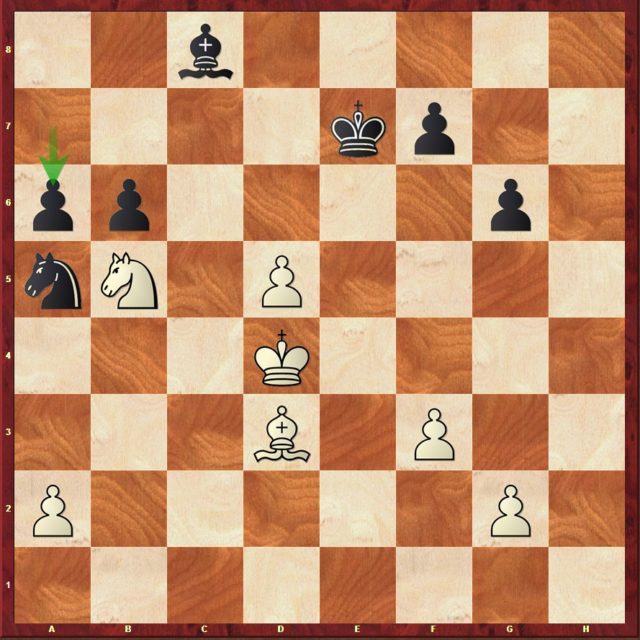
If he had played 34.Nc3! instead of going for the a6-pawn with 34.Nc7?!, I would have had no chance of surviving. Indeed, he would have quickly forced …b5, in particular to give the c5 square for his King; and if I move the Bb7 to give a6, my Na5 still doesn’t move anywhere, which changes everything compared to the game, where he could pass to d6 via b7! After 34…Kd6 35.Nxa6 Nb7, I didn’t understand 36.g4? atall, which facilitated my defense. By the way, it seems that there is a forced draw after 36…Nc5!, but in the heat of the moment, I did not understand it; it must be said that it was not at all obvious! Indeed, it seemed to me that the Bishop ending is lost after 37.Nxc5 bxc5+ 38.Kc3 f5 39.gxf5 gxf5 40.Bc4 f4 41.a4 Bh3 42.a5 Bg2 43.a6 Kc7; there are several ways to win here, but the most aesthetic one is 44.d6 Kxd6 45.Bd5!. On the board, the natural 38…Kxd5 (instead of 38…f5) 39.Bc4+ Ke5 40.Bxf7 g5 looked highly suspicious to me; however, it seems that it draws according to the computer!
So I gave up 36…Nc5! for 36…g5?. As the game unfolded, all I could hope for was a kind of fortress with the Knight on d6. But I had nevertheless slight doubts; if, for example, he managed to put the King on b4, then the Bishop on c6, and play Nb5, I was not sure that the fortress would hold on. For example, a4, Nc7-a8 and the b6-pawn is still not completely serene. So I decided to take a little more active steps by bringing the King to c5.
Later on, after 56.gxf5,
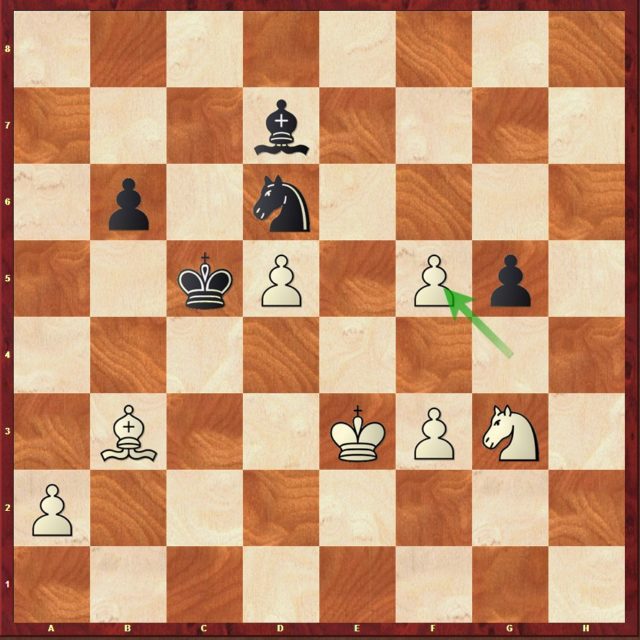
I discarded the natural 56…Nxf5 57.Nxf5 Bxf5 58.f4 g4 because of 59.Kf2, but in fact, as Wang Hao told me after the game, here 59…b5! 60.Kg3 (60.a3 b4! 61.axb4+ Kxb4 and White doesn’t have enough pawns anymore) 60…b4 forces the draw. But as on the other side, I had felt that 56…Bxf5 57.Nxf5 Nxf5+ 58.Ke4 Nh4! would be a fortress, I chose this option. I also envisioned scenarios where my fortress could scrumble. So, I was very careful and I calculated carefully each of my moves!
All in all, still a very bad performance on my part, but it’s crucial to be able to save those games!
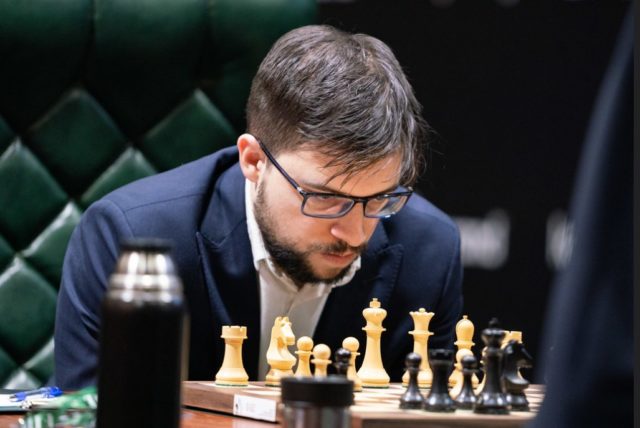
Round 7: Mvl – Nepomniachtchi (2774) 1-0
I wasn’t necessarily expecting the French, but even so, as Ian had already played it earlier in the tournament (against Alekseenko), we had to take it into account. So we looked at how to pose problems, which is not the most complicated against the Winawer 🙂 . However, you have to be ready to take a minimum of risks, of course…
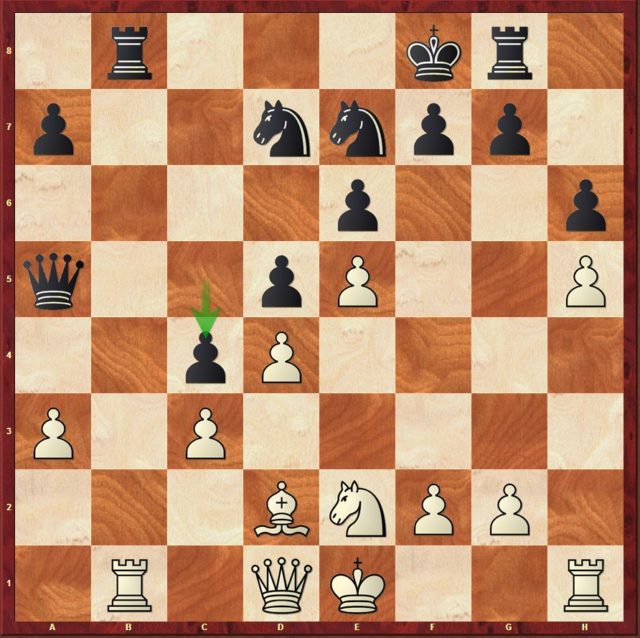
Round 7: Mvl – Nepomniachtchi (2774) 1-0
I wasn’t necessarily expecting the French, but even so, as Ian had already played it earlier in the tournament (against Alekseenko), we had to take it into account. So we looked at how to pose problems, which is not the most complicated against the Winawer 🙂 . However, you have to be ready to take a minimum of risks, of course…
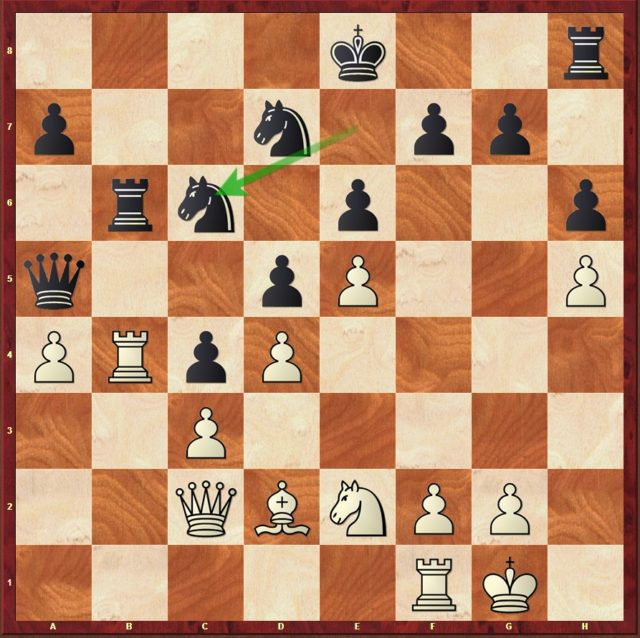
Later, after 22…Nc6, I anticipated sacrificing the exchange on b4. I knew there were probably other ways to play of course, but I liked the concept. And my original idea was to do it with 23.Rfb1… But when I saw that I could also play 23.f4 directly, I didn’t hesitate for a second! But the path was narrow for the concept to work, after Black tried to close the position with 23…Ne7 24.Rfb1 f5. But the fact that in the structure, there is now this idea of breaking with g4! was finally crucial. And this is indeed what happened a few moves later. There is still an important point to mention though, to show it was all but smooth.
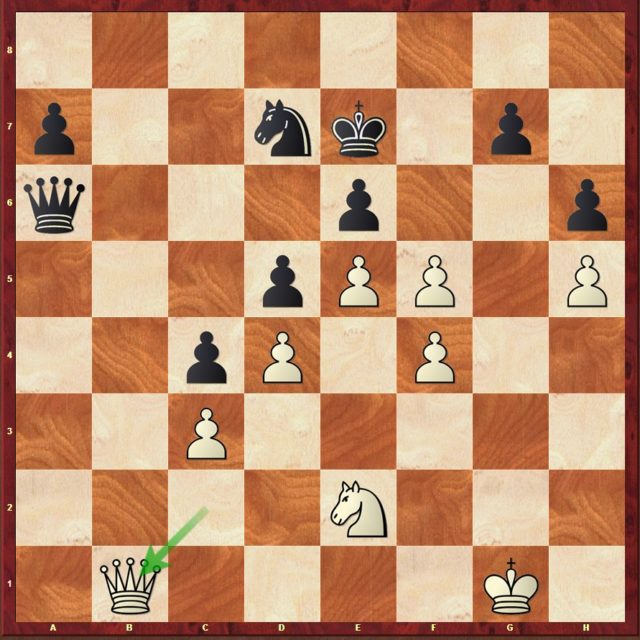
Here, instead of 32…exf5, Ian could try 32…Qb6. I think it must lose too, but it was a much better practical chance. For me, at the board, the move was 33.f6+. But in fact, after 33…gxf6 34.Qh7+ Kd8 35.Qxh6, Black has 35…fxe5 36.fxe5 Qb1+ and it is already perpetual. And if I try to anticipate with 35.Kf2, then Black has the miracle resource 35…fxe5 36.fxe5 Ke8! 37.Qxh6 Nf8 and everything holds, for example 38.Qg7 Qb1! and the h-pawn will not go far. A posteriori, the machine shows that the correct move against 32…Qb6 was 33.Qa1!, but it is clear that Ian and I both considered that it was 33.f6+ which would have refuted 32…Qb6.
In the game, after 33.Ng3 followed by 34.Nxf5+, I still had to be concentrated and precise not to let the whole point escape.
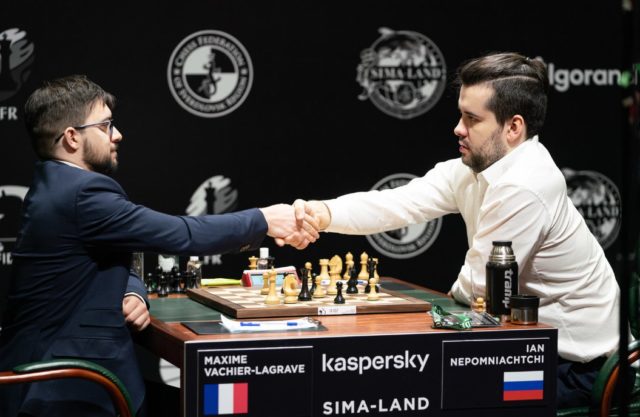
In terms of both results and content, this first half of the Candidates’ Tournament is obviously very positive for me. This is the case from the point of view of the preps, but also in my play itself. But obviously, absolutely nothing has been achieved yet, and there are a lot of things that are going to happen in the second half. In fact, when the tournament resumes, I’m going to start with black against Caruana and Ding Liren; it’s going to be a complicated and very important passage. There will also be the penultimate game with black against Nepo, the current co-leader. As things stand now, that game has the potential to be decisive for the tournament’s victory. But generally speaking, all the games are going to be very important, and every half point will count. If I play at the level I’ve shown so far in Ekaterinburg, I’m obviously one of the big favourites to win. But it’s up to me to prove it…
The tournament has been suspended following the Russian government’s announcement of the imminent closure of its airspace. We were able to leave the country in the dead of night, thanks to the chartering of a private jet that dropped Caruana and I – and a few others – at Amsterdam airport 🙂 .
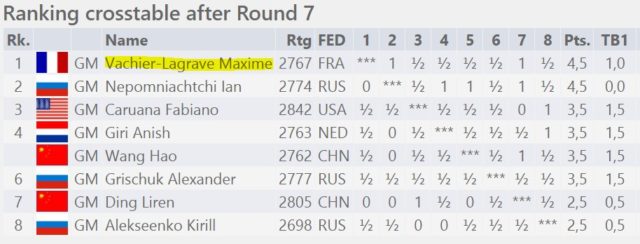
So halfway through, I’m sharing the lead with Ian Nepomniachtchi. With 4.5/7, we are one point ahead of the chasing group. Until the tournament resumes, I’m going to stay quietly at home for as long as it takes. I’m still going to keep up my physical fitness and my game though. In fact, I’ll be taking part in the Carlsen Invitational online tournament, which starts on April 18 and will bring together the best players in the world. Then the time will come when I’ll have to step up the pace, obviously; when things will be clearer and a bit better in the world.
Personally, I have the feeling that the activity in general, and the chess activity in particular, will not resume before at least the beginning of September…
In this period of containment, the chess on the Internet has the wind in its sails, and there are lots of initiatives. Unable to cope with the (very) numerous requests from French chess clubs to participate in one of their online tournaments, Maxime has decided to propose a simultaneous display. He will thus play on Friday, April 10th at 6 pm, against 20 opponents previously drawn among the interested persons who will have registered. Modalities to be discovered very soon on the MVL’s social networks 🙂 .
GAMES
Maxime’s games
